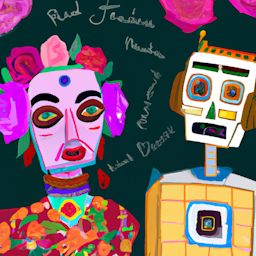Alright, time for a little heart-to-heart. As creatives, we're not exactly known for thinking like engineers or developers. I mean, why would we? We're all about that right-brain life.
We’re busy color-coordinating our thoughts, not mulling over how AI minds tick.
I've been known to play it loose and fast with a few words when it comes to prompting generative AI. Failed to set up the context? Meh, it'll figure it out. Meanwhile, my tech-whizz colleague was developing an involuntary twitch.
After one too many forehead-wrinkling slip-ups and a steady soundtrack of Sam's smug 'I told you so,' I've got my hands on a couple of golden rules for chit-chatting with AI. Plot twist: even we, the right-brained rebels, can wrangle these bots. We just need to arm ourselves with a few logic-infused guidelines. Bet you didn't see that coming, huh?
Foolproof left brain rules for creatives using generative AI
1. Play the context card
Feels like something that should've been filed under "obvious," right? But yours truly clearly missed that memo. As a writer, I was itching to dive headfirst into the good stuff. But AI? It's not some psychic hotline. It's the stubborn co-worker who won't lift a finger without the full brief. Crave results? Toss in a dash of context.
2. All hail information architecture
"Who needs structure?" I scoffed, firing off my ChatGPT prompts with reckless abandon. Little did I know that my shot-in-the-dark approach wasn't doing me any favors. Don't follow my haphazard footsteps. Channel your inner Marie Kondo and structure your content like you mean it—H1s, H2s, and all. Suddenly, you're whispering sweet nothings into AI's digital ear.
3. Next in order: your sentences
Who'd have guessed that shuffling your sentences could sway your AI results? Not me, but here we are. I was riding my inspiration train and typed in the words as the muse was striking them. Cue the output that would make Hemingway scream with terror. Make sure your juiciest tidbits come first. AI isn't here for your cliffhangers.
4. The devil's in the details
Believed AI would catch your drift with a few words missing? Guilty as charged. One or two words off can't be earth-shattering, right? Spoiler alert: in the world of AI, it's like forgetting to turn the oven on when baking cookies. A minor detail with major consequences. Don't make AI guess your half-baked thoughts. Spell. It. Out.
5. Formatting rules
I was under the impression that bullet points and headings were for attention-span-challenged humans, not machines. Obviously, another techy insight I wasn’t CC’ed on. Make no mistake, formatting is the universal language. So tidy up your prompts and your AI companion will thank you.
W.W.R.D.?
- Next time you’re turning to generative AI for some brainstorming help, establish context, use the correct information architecture, the right order of sentences, don’t skip important words, and utilize formatting.
- Don’t do this:
“Write an article about the struggles creatives face when using generative AI.”
- Instead, use a structure:
“Hey Rebekah is a free daily newsletter. It's like Morning Brew for freelancers, powered by machine learning. It's produced by a team of elite freelancers. The purpose of the company behind Hey Rebekah is to make knowledge free. Do you understand?”
“You are now a copywriter for Hey Rebekah's newsletter. I need your help to draft an article. I need you to frame your responses in the context of the company's mission. The mission is to upskill the global workforce, starting with freelancers. I want you to make sure that your responses are framed within JTBD, ODI and First Principles. I want you to make sure that your responses score at least 90 on the Flesch Kincaid reading score. Do you understand?”
“Write a 300-word article for Hey Rebekah's newsletter about the struggles creatives face when using generative AI. Focus on how they fail to understand the importance of establishing context, using correct information architecture, the right sentence order, including all the important words, and following the right formatting."
Check out the difference in output here
About Susan Rov
Susan traded cocktails and lattes for words that move. As a copywriter on a mission to end boring, she brightens brands and makes an impact. Number 463 on the list of fiction readers left standing, you'll find Susan at sunrise—running, writing, and wondering how to change the world next. That drive led her to become a founding team member of BRIL.LA.

